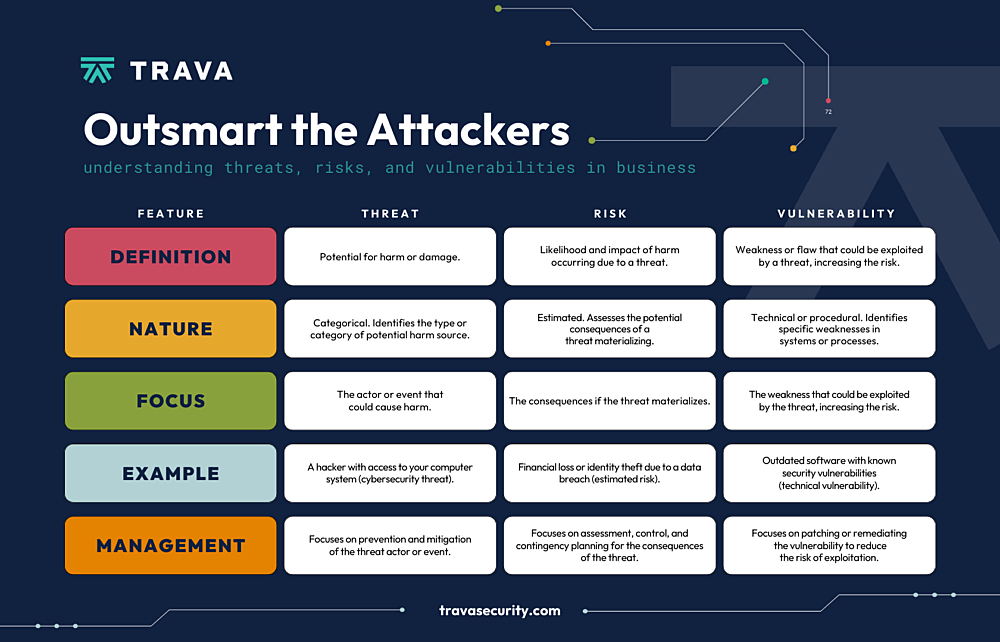Last updated: June 10, 2025
Table of Contents
- Words Matters, Particularly in Cybersecurity
- Risk Vs. Threat Vs. Vulnerability
- What are threats?
- What is vulnerability?
- How to fix cybersecurity loopholes
- What does risk mean?
- How Do You Identify Threats and Risks?
- How to manage your cybersecurity risk
- Cybersecurity Doesn’t Have to Be Complicated
- A Reliable Cybersecurity Partner is Ready to Help
Cyberattacks are growing rampantly in complexity and number, and criminals are now more cunning and daring than ever. In a nutshell:
- The average cost of data breaches is increasing every year. In 2022, businesses lost $4.35 million, $0.11 million more than in 2021, and 12.7% higher than in 2020.
- Data breaches are at a historic high, with approximately 15 million records exposed during 2022’s third quarter.
- Companies lost over $3 billion in 2021 to decentralized finance (DeFi) thefts.
- The DDoS Intelligence system by Kaspersky noted a whopping 57,116 DDoS attacks during 2022’s third quarter.
Such alarming trends have forced companies across the globe to reevaluate their cybersecurity postures and implement decisive approaches. But while strategies vary, enhancing network security begins with understanding safety and security terminologies.
Words Matter, Particularly in Cybersecurity
Cybersecurity, like any other sector, has its unique lingo. What sets security jargon apart is how precise experts use niche terminologies and phrases within their language. But these terms may seem interchangeable to novices or lay people, who often blend them.
And since cybersecurity comprises multiple moving parts, anyone inexperienced with vulnerability management can easily get them mixed up.
Arguably, “threat,” “vulnerability,” and “risk” are among the most commonly confused terminologies. But unfortunately, twisting these words limits your grasp of today’s cybersecurity management technologies and tools. It can also hamper communication with other professionals on relevant topics.
Fortunately, the next section will guide you.
Risk Vs. Threat Vs. Vulnerability
So what do “threat,” “vulnerability,” and “risk” entail?
In essence, risk refers to the potential for destruction, damage, or loss of data or assets, resulting from a cyber-threat. On the other hand, a threat is what magnifies the chances of an adverse event, like a threat actor exploiting a vulnerability inside your system.
Finally, a vulnerability is simply a weakness in your applications, networks, or infrastructure that exposes your data and assets to threats.
Let’s review each of these terms in detail.
What are threats?
If you’re trying to protect an asset, then you’ll be shielding it from a threat. The term refers to anything that can accidentally or intentionally exploit a vulnerability and damage, destroy, or obtain an asset.
Online, your company website and data are the assets. A hacker and their tools (like malicious code) would be a cyber threat. The criminal can install the code on your site, which can infiltrate your platform and shut it down or install viruses.
The main types of cyber threats are intentional, unintentional, or natural.
- Intentional threats: Things like malware, ransomware, phishing, malicious code, and wrongfully accessing user login credentials are all examples of intentional threats. They are activities or methods bad actors use to compromise a security or software system.
- Unintentional threats: Unintentional threats are often attributed to human error. For example, let’s say you forgot to lock the back door before leaving for work. While you’re at the office, a thief seizes the opportunity to sneak into your home and steal your valuables. Even though you didn’t mean to leave the door unlocked, the thief took advantage of your home’s vulnerability. In the cybersecurity industry, someone might leave the door to the IT servers unlocked or leave sensitive information unmonitored. An employee could forget to update their firewall or anti-virus software. Current and even former employees may also have unnecessary access to sensitive data, or simply be unaware of the threats. (Which is why employee training is so important.)
- Natural threats: While acts of nature (floods, hurricanes, tornadoes, earthquakes, etc.) aren’t typically associated with cybersecurity, they are unpredictable and have the potential to damage your assets.
HOW TO STAY AHEAD OF CYBERSECURITY THREATS
Awareness is the best way to prepare for threats. You must stay current on data breaches, cyberattacks, and the methods hackers use to accomplish them. The most common hazards include malware, MitM (man-in-the-middle), DDoS (distributed denial-of-service), SQL injection, and phishing.
To protect yourself from cyber threats, continuously monitor all data environments and use two-factor authentication. You should also teach your employees how to recognize phishing attempts and other tactics cyber criminals use to trick people into helping them gain access to sensitive data.
What is vulnerability?
Vulnerability refers to a weakness in your hardware, software, or procedures. It’s a gap through which a bad actor can gain access to your assets. In other words, threats exploit vulnerabilities.
Take Kaseya. The FBI described the incident as “a vulnerability in Kaseya VSA software against multiple managed service providers (MSPs) and their customers.” Huntress, a cybersecurity firm, tracked 30 MSPs involved in the breach and concluded that the attack was due to an authentication bypass vulnerability in Kaseya’s VSA web interface. It allowed attackers to work around authentication controls and upload malware.
You should know that small to medium-sized businesses tend to be more vulnerable to attacks. That’s because few can afford a dedicated IT/security department, making it less likely that there are security procedures in place. (That said, cyber attacks affect companies of all sizes.) Companies should be aware of their threats and vulnerabilities in order to identify and respond to all of the risks. To determine the best way to approach a specific threat, perform regular threat assessments. Or try penetration testing, which recreates real-world threats to discover vulnerabilities.
How to fix cybersecurity loopholes.
Proactive vulnerability management is the key to sealing website susceptibilities. Therefore, you should consider vulnerability management software for regular scans and assessments. Moreover, you must align your cybersecurity policy with ISO 27001 standards, implement strict access control, and create a robust contingency plan.
What does risk mean?
This is where vulnerabilities and threats intersect. At its core, risk refers to the possible implication of the damage or loss of business assets and data.
While it’s impossible to eliminate risk in its entirety, you can manage it to a level that aligns with your company’s tolerance. So don’t aim to achieve a risk-free system, but one with the lowest risk possible.
Notably, cyber risk is a function of threats leveraging system vulnerabilities to access and compromise or steal assets. It’s best summed up with this formula:
Risk = Threat + Vulnerability
Understanding these distinct concepts can help you determine your website’s overall safety. Of course, like cyber criminals, threats exist. But you’ll have the lowest risk when you don’t have vulnerabilities.

How Do You Identify Threats and Risks?
Your first step toward properly responding to a threat or mitigating a risk is to identify it. But this is easier said than done when security risks and threats often seem like nothing more than a misconfigured setting or an annoying email.
The difference between threat vulnerability and risk in cyber security is that while risks are a passive danger, threats are an active one. That means you can only identify a threat once an attacker targets your organization.
But that doesn’t mean your only option is to wait until it’s too late. There are many early warning signs that you should keep an eye out for:
- Repeat login attempts: An unusually high number of failed login attempts on company accounts is a sign someone’s trying to force their way past your password.
- Unexplained activity: Large amounts of data being transferred around or outside the network without prior authorization can be a sign of an insider threat.
- Suspicious email requests: A high frequency of inauthentic emails requesting confidential information from employees is known as a phishing scheme. Phishing is usually used as an “avenue of attack” rather than the end goal.
Meanwhile, detecting security risks requires continuous active monitoring, testing, and assessments of your infrastructure. Automation is a great help for network scanning, as manual check-ups can be incredibly time-consuming.
How to manage your cybersecurity risk
Considering the impossibility of eliminating cyber threats, risk management can be the most effective approach to enhancing your cybersecurity posture. This is an ongoing routine practice where experts review your risk environment to minimize the likelihood of specific threats.
Cybersecurity Doesn’t Have to Be Complicated
A robust security strategy is your only way of navigating the treacherous cybersecurity landscape. Organizations must heed the above recommendations to ward off threats, seal vulnerabilities, and reduce cyber risks.
But creating an effective plan that can seal all the loopholes and fight back threat actors is easier said and done.
A comprehensive program requires lots of resources and effort. But however daunting it may seem, the legal, financial, and reputational implications of cyberattacks outweigh these costs by far. Thus, you cannot afford to compromise.
Savvy organizations, especially SMEs, are overcoming the hurdles by partnering with reputable cybersecurity experts instead of relying on on-premise solutions. This can be a valuable decision, as it can help you:
- Boost your security cost-effectively
- Gain insights from industry experts
- Monitor your systems in real-time and conduct instant analysis
- Save time to focus on core business
- Leverage a proactive approach that focuses on prevention than cure
- Heed cybersecurity standards and compliance requirements
You’re on the right site if you’re looking for all these.
A Reliable Cybersecurity Partner Is Ready to Help
The experienced team at Trava understands that you need unique solutions to your cybersecurity needs. Our experts can meet you where you are and help your company minimize threats, fix system vulnerabilities, and transfer risk through insurance.
So don’t hesitate to contact us.


